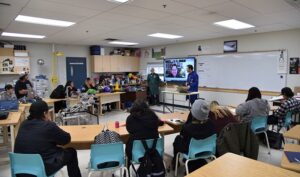Biiwaabko Nimosh: Taking us places

By Walter Quinlan
WIIKWEMKOONG UNCEDED TERRITORY — Could someone from Wikwemikong High School work at NASA? “Yes, of course, for sure!” replied NASA mechanical engineer Aaron Yazzie when he virtually met with the robotics team and science students this January.
Yazzie is Diné (Navajo) who grew up amongst the canyons and pastel-coloured mesas of northeastern Arizona. He studied at a small-town public school and went to Stanford University on a scholarship.
Since 2008, Yazzie has worked at the NASA Jet Propulsion Laboratory, designing mechanical systems for their robotic space search missions. He is part of the team that designed and built “Perseverance” – the Mars Land Rover.
It was a journey with challenges.
“When I left my home to go to Stanford, that was a big culture shock, and I had a lot to learn,” he said. “I sought out study groups, peer groups, and extra time with my professors.”
Yazzie’s story inspired the students.
“It’s not every day that you get to meet someone like Aaron,” said Baybee Bryant. “I like that he kept trying and trying.”
The robotics team from Wiikwemkoong has a proud tradition. Established in 2015, they reached the FIRST Robotics world championships in 2019, winning the prestigious Chairman’s Award.
Every January, FIRST Robotics releases a game worldwide. Teams spend time doing strategic analysis, developing a game plan, and designing and building a robot to effectively play the game.
“These are large-scale industrial robots,” explained Chris Mara, Wikwemikong High School science teacher and robotics team coach. “They weigh 125 lbs and can travel 15 feet per second.”
Wiikwemkoong’s robot is the “Biiwaabko Nimosh” (Iron Dog), named by the grandmother of the first robotics team captain Annie Wemigwans, Julie Wemigwans.
Yazzie and the students found that they have a lot in common.
“The things I do in my job every day are very similar to what they are doing now: design parts and mechanisms,” he said.
The team recently completed their design work for this year’s FIRST Robotics competition. They are now building a robot that must “pick up and place objects on a scale of low, medium, and high difficulty,” said robotics team member Zander Shawongonabe.
“We’re all one team,” said Pahquis Trudeau. “But we work in smaller groups and we all have our specialties.”
Aaron agrees with this approach.
“Engineering isn’t just about being smart at math and science. It’s about being creative, working together on a large team, and becoming a well-rounded leader,” he said.
Teamwork is about problem-solving, too.
“Problems that seem impossible but that the students are working out,” said Aaron, citing electronics as an example.
“There are lots of wires in a big robot,” Zander said.
The idea to bring Aaron to Wiikwemkoong originated with Dominic Beaudry of Science North’s Indigenous Advisory Committee and funding was provided by the Ministry of Education. Matthew Graveline, an outreach staff scientist at Science North, hopes there will be more opportunities for Aaron to visit the north.
This year at Wiikwemkoong, they face a new challenge.
“There are no veterans on the robotics team,” said Mr. Mara.
Still, the team of engineers and scientists can count on a coach proud of their courage and openness to take on any challenge that may come their way.
For Pahquis Trudeau, the robotics team is part of his long-term learning path.
“I want to take mechanical engineering in the future,” he said. “And why not take this opportunity to learn about mechanics and robotics?”
And for Zander Shawongonabe, “the best of all is building the robot. It’s amazing, very cool. It makes me feel like ‘We built that,’ and hopefully, it takes us places.”


